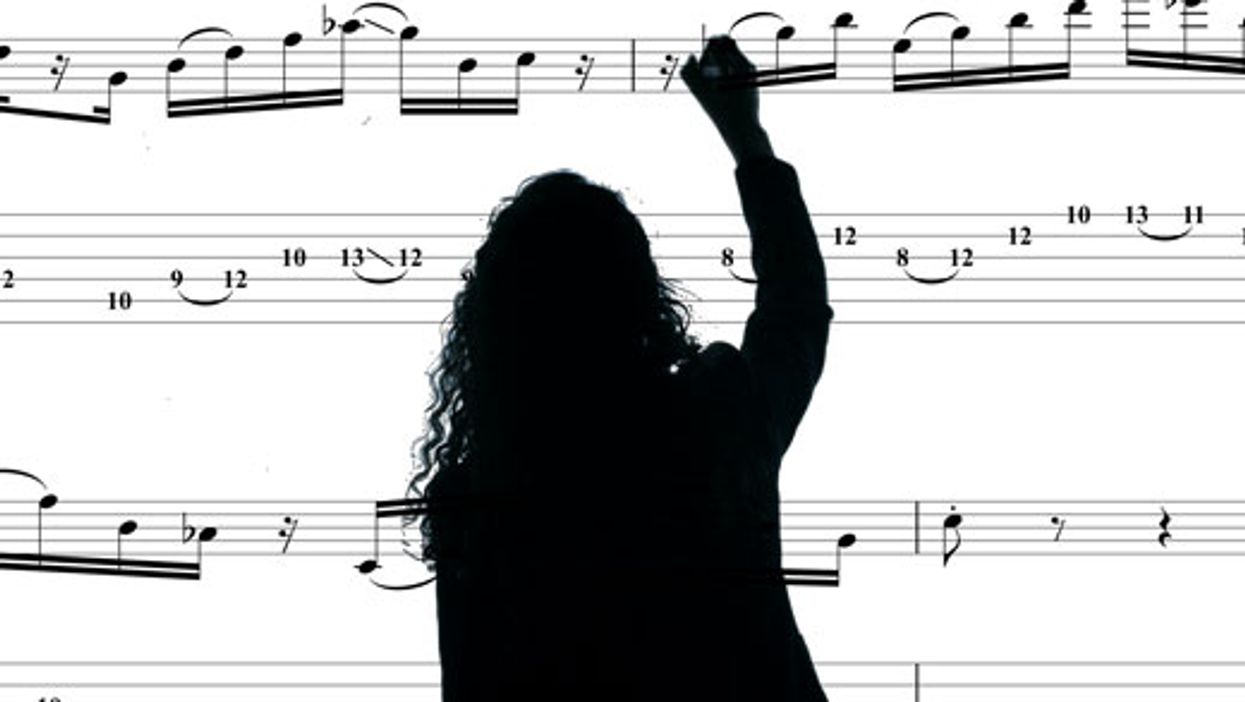Theory: Intermediate
Lesson Overview:
• Learn how to systematically compose a melodic solo.
• Understand the elements of 2-string arpeggios.
• Improve your alternate and economy picking. Click here to download a printable PDF of this lesson's notation.
Today, let’s check out some of the lead guitar work on Ozzy Osbourne’s solo albums. After basically inventing heavy metal with Black Sabbath in the early ’70s, Ozzy launched a successful solo career aided by the powerful guitar work of the legendary Randy Rhoads. After Randy tragically died in 1982, the torch was carried on by Jake E. Lee and later by modern-day Viking, Zakk Wylde.
Ozzy’s solo albums are classics, and his guitarists have influenced generations of players across many genres. Randy introduced a classical influence into the music that would later be adopted and expanded into neoclassical shred by Yngwie Malmsteen. Randy’s playing and tone changed the game and there was even a guitar body shape named after him, the asymmetrical V-style Jackson Rhoads.
Jake’s style sounded a lot more like mid-’80s glam, and while the albums he wrote and recorded with Ozzy are cult classics, he never reached the fame of Randy or Zakk. In this lesson, rather than present a complete breakdown of these great guitarists’ technique, I’ll give a few examples to illustrate their distinctive styles. The goal is to offer tools and licks to expand your vocabulary and let you reference Rhoads, Lee, and Wylde in your own playing.
To get an authentic sound, you’ll need a Marshall-style tube amp like a plexi or JCM800, or a pedal that emulates that tone, like the Wampler Plexi Drive or Exotic SL Drive. Also, note that I’m tuned down a half-step for the examples in this lesson.
Let’s start chronologically with Randy Rhoads. He used a lot of trademark licks that made his playing very recognizable, and he rarely improvised solos. Ex. 1 mixes the C# natural minor scale (C#–D#–E–F#–G#–A–B) and the C# minor pentatonic (C#–E–F#–G#–B). The first measure is a signature Rhoads phrase. Make sure to pick the two A notes on the 2nd string and the two F# notes on the 3rd string to get that extra “Randy” flavor. In the second measure, I use a repeating pattern that moves up chromatically before resolving with a bend up to the root. These chromatically shifting patterns appear often in Randy’s playing and he typically used them as short leads to fill in between riffs, as in the chorus of “Crazy Train.”
Click here for Ex. 1
Ex. 2 is a tapping phrase that Randy used in some of his solos. It's a simple sextuplet pattern that I combined with a classical sounding Am–F–G7 progression. Over the G7 chord, I work through a Bdim arpeggio (B–D–F) before ending on a bend to resolve it.
Click here for Ex. 2
Ex. 3 highlights another trademark Randy sound. When playing an arpeggio, he’d trill every note to give the phrase a classical edge. After the arpeggios, I ascend the neck with a simple E minor run.
Click here for Ex. 3
Ex. 4 dives more into shred territory with a pattern Jake E. Lee used prominently at the end of his solo in “Bark at the Moon.” This two-string sextuplet pattern shifts up the neck through the B Aeolian (B–C#–D–E–F#–G–A) scale. I notated it on the first two strings, but you can play it on any pair of strings. Feel free to shift the pattern across different pairs of strings to find where you like it best.
Click here for Ex. 4
While Randy played mostly in straight subdivisions, Jake would rely on triplet-based patterns for a more unpredictable sound. Ex. 5 is a lick based in F# minor pentatonic (F#–A–B–C#–E) with a b5 (C) thrown in for a bluesy flavor. It combines a few simple rock clichés in the first measure that Jake used quite a lot, but he made it more interesting by switching to a binary feel for the second half of the first measure. The fast triplet phrase in measure two is a lick Jake used in many solos.
Click here for Ex. 5
Our final lick in Jake E. Lee’s style (Ex. 6) will set your fretboard on fire. A simple sextuplet pattern using the D minor pentatonic scale (D–F–G–A–C), it’s a phrase he used in some recorded solos, but was a staple during live shows. You can move this pattern through the pentatonic scale all over the neck, but Jake mostly used it as a repeating pattern in a single shape.
Click here for Ex. 6
While Jake was an ’80s rock/shred player, Zakk took shred and combined it with his own flavor of Southern rock and country. Zakk’s alternate picking skills are legendary, but where possible he often used economy picking. In Ex. 7 you can see one of his economy-picked ideas based in D major pentatonic (D–E–F#–A–B). Notice how he took a three-note pattern and made it more rhythmically interesting by playing it as 16th-notes. Zakk famously used this technique in his “Miracle Man” solo.
Click here for Ex. 7
Showing more of Zakk’s Southern-rock influences, Ex. 8 is a bluesy pentatonic lick that starts with a triplet-based rock move that brings to mind Skynyrd solos from the ’70s. In the second measure, I focused on bringing out the F# blues scale for added vibe.
Click here for Ex. 8
Ex. 9 starts with a repeating pattern that is classic Zakk. He has used this—and many other repeating patterns like it—throughout his career. And you can too, but remember: There’s always the risk of sounding like a rip-off if you overdo it. The first sextuplet pattern moves up through two pentatonic shapes before going into a descending sextuplet pattern. The lick ends with that same ascending three-string pattern, but played as 32nd-notes, which shifts the accents.











![Rig Rundown: AFI [2025]](https://www.premierguitar.com/media-library/youtube.jpg?id=62064741&width=1245&height=700&quality=70&coordinates=0%2C0%2C0%2C0)





